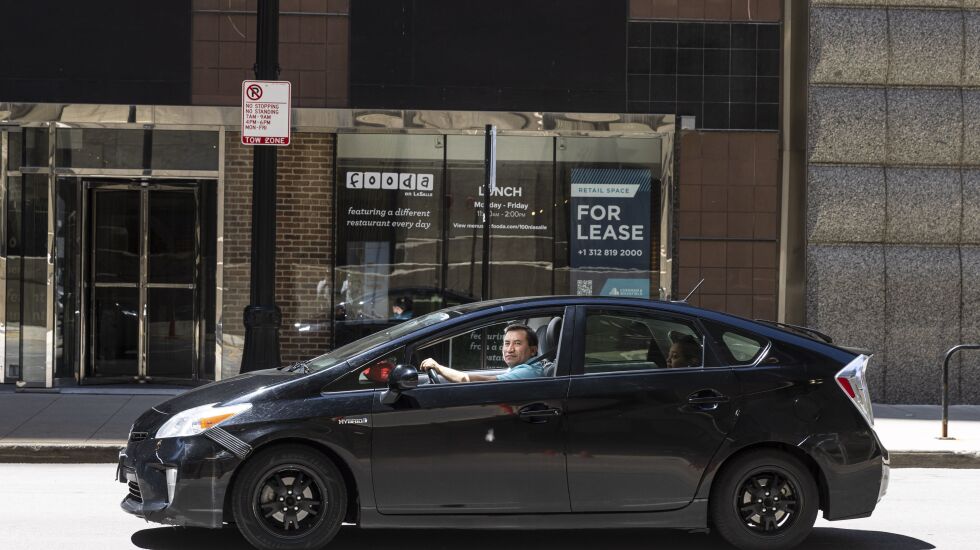
Even before gas prices soared across the country, ride-hailing driver Martinelli Quintanilla tried to stretch his gas tank as much as possible.
Quintanilla — who also works in the hospitality industry — drives a Toyota Prius, which uses a gasoline engine and electric motor to power the car, to save on gas and stays in the Loop during peak hours to draw better tips and tries to take trips under 30 minutes. It’s part of his strategy to make as much as he can in the gig economy while trying to maximize his fuel.
It usually costs Quintanilla, 51, about $60 to fill up his gas tank, which he usually has to do every two days. When he works in his hospitality job in the suburbs, Quintanilla leaves his Chicago home about an hour and a half earlier to do ride-hailing jobs along the way.
“I go to work picking up people, and I usually make $40 to $50,” Quintanilla said in Spanish. “Going back home, I make another $50 to $60. This is taking advantage, especially now, of the gas prices. I don’t waste a mile.”

In recent weeks, gas prices in Illinois have surpassed $5 a gallon, according to an analysis from GasBuddy. There have been some decreases in the average price, but prices are likely to soon surge to $6 a gallon with prices peaking in July, said Patrick De Haan, the head of petroleum analysis for GasBuddy.
Gig workers — who work as independent contractors — gave people rides and delivered groceries and restaurant take-out orders throughout the coronavirus pandemic. A Pew Research Center survey in August 2021 found that Hispanic adults, about 30%, were more likely than any other racial or ethnic group to do gig work. Black and Asian adults were also more likely to do gig work than white adults, the survey found.
Some of these workers took a hit during the pandemic. Ride-hailing drivers in Chicago like Quintanilla decreased from 110,288 in September 2019 to 66,548 in September 2020, according to a report from the University of Illinois Labor’s Project for Middle Class Renewal.
And even before the economic uncertainty of the pandemic, there were questions surrounding whether these workers were making minimum wages after accounting for expenses. Now many are trying to make the most of their income while trying to keep up with soaring prices such as fuel.
Gas prices started to increase when Russia invaded Ukraine, but the increasing costs are also driven by the diminished capacity of oil refineries, meaning the refineries’ supply can’t keep up with the demand.
\“There’s just less refinery capacity than there was several years ago because of COVID, because of Hurricane Ida shutting down a refinery last summer, because of a refinery fire in 2019,” De Haan said. “That’s making it very difficult for refineries to meet demand.”
Drivers can make the most of their gas tank by reducing their speed 10 to 15 miles per hour, slowing down the pace of acceleration and using cruise control, De Haan said, adding that taking part in loyalty programs at gas stations can also help lower prices.
Companies that many gig workers use have tried to provide some relief for drivers. In March, Uber implemented a surcharge for consumers ranging from 45 cents to 55 cents for each ride-hailing trip, and a surcharge ranging from 35 cents to 45 cents for each Uber Eats delivery because of gas prices, according to a news release.
Lyft, another ride-hailing company, implemented a 55 cent fuel surcharge for each ride in March, and as of Tuesday it remained in place until further notice, according to a company spokesperson.
During the first quarter of 2022, ride-hailing drivers in the Chicago metropolitan area were making about $13.99 per trip, which was slightly above the $12.42 they were making per trip during the first quarter of 2021, according to a data analysis from Gridwise, an app that allows gig workers to track their earnings.
Food and grocery delivery drivers saw a dip in earnings per trip during that same time period. During the first quarter of 2022, grocery couriers were making $16.14 a trip, down from the $18.33 per trip they made during the first quarter of 2021, according to the Gridwise data.
Overall, the Gridwise data shows the monthly gross earnings for these type of gig workers was up compared to the first quarter of 2021, but their earnings had dipped from what they were making at the end of 2021.
Micheal Quentin, who previously worked as a ride-hailing driver, switched to food deliveries during the coronavirus pandemic.
In recent weeks, Quentin, 27, of Chicago, has noticed they haven’t always been able to fill the car’s gas tank, and it seems like a larger portion of their income is paying for fuel. Quentin estimates they make about $600 a week delivering food.
“I do instinctually try to avoid the shorter rides because I know starting my car engine over and over again, it will use up a little bit of chunk of gas more than just driving around,” Quentin said. “I’ll try to go for the longer rides because I’ll make more money, and I’m less likely to be starting up my car over and over again.”
Quentin is hoping to become a game developer, but it’s not just the increasing gas prices pushing them to switch industries. Quentin is also figuring out how to pay off $200 worth of parking tickets they recently got while picking up food deliveries from restaurants.
“It was a major detraction from my income, and it nullified a couple days that I worked,” Quentin said.
Gia, who asked that her full name not be published out of fear it might effect her work, said she’s been doing grocery deliveries full time since about 2014, but she’s recently started considering changing jobs as her income has declined.
“With gas, I’m paying over like $60 every two days, and so if I’m not making that then it’s not worth to be out here,” the 48-year-old woman said.
At the beginning of the pandemic when residents were staying home, Gia sometimes made $1,200 every week delivering groceries in Chicago. But her take-home pay has started to decrease, and she recently made only $378 after doing deliveries for five days.
She thinks her wages are changing not just because of fuel prices but also because of how the delivery apps work, along with changes in consumer habits and tipping.
Gia, who also sells jewelry she makes, recently sold her condo and moved back in with her family. At the gas pump, she’s changed the type of gas she purchases and usually goes to somewhere like Costco that typically has lower fuel prices.
“I am looking for another job because this job is now to the point where it’s not paying my bills anymore,” Gia said.
Elvia Malagón’s reporting on social justice and income inequality is made possible by a grant from The Chicago Community Trust.







